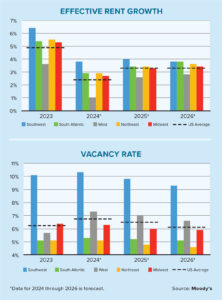Commercial mortgage underwriting is usually discussed in terms of asset performance, such as rents, occupancy, expenses, valuations and debt loads. But we can’t forget that traditional lenders, especially banks, also are evaluating the borrower. These borrowers are usually a business or corporation, and gauging the risk of a particular business can be complicated.
Banks use a number of accounting metrics to gauge a borrower’s credit-worthiness and these are worth learning. Unfortunately, it also is true that some banks automatically disqualify certain business types for no rational reasons. Commercial mortgage brokers should take time to understand how underwriting standards develop and evolve, as well as some of the finer points of the process.
Fundamental lending practices are constantly changing. They are frequently rewritten by banks to reflect evolving economic conditions, aggressive competition, bank management philosophy, market objectives and, to some extent, recent experiences with specific industries. After every economic event there is confusion and uncertainty within the market. Over time, a bank’s new lending strategy permeates the entire organization and new credit standards appear.
Commercial mortgage brokers should stay abreast of the changes in each of their lending relationships. You need to stay up to date to give yourself the best chance of success. Lenders want to receive a complete loan application with a financial analysis that demonstrates the inherent risks. The analysis should justify why the bank should approve the request.
Influence of leadership
To some mortgage brokers, a bank’s lending criteria may appear overly conservative and designed to decline most loan requests, with no basis in reality or standards that are inconsistent from bank to bank. Of course, there are institutional differences between lending cultures and policies, but all successful banks have three basic priorities: safety and soundness, profitability and growth.
Generally speaking, a bank’s policies will reflect standard underwriting concepts used by the vast majority of its competitors. It is important to note, however, that a bank’s philosophy also reflects the attitudes of its management — and these attitudes are influenced by these individuals’ varying experiences. On occasion, individual preferences can lead to bad policies within a bank that eventually become fixed within the institution’s culture. Sometimes these attitudes are exported to competing lenders.
Say, for example, that a bank’s senior lending officer has had a negative experience with a transportation company, a real estate developer, a car wash or an electronic assembly plant. There’s a strong probability that the bank will make it more difficult or more expensive for these out-of-favor business types to obtain a loan.
This can translate into a higher downpayment requirement, shorter repayment terms, higher interest rates or even an unwritten rule not to do business with a particular business sector. Bank policies are based on a greater perceived risk associated with the subject industry, simply because an influential member of the bank may have had a bad experience with a particular business type. This lending practice is simply wrong and should not be permitted in a judiciously managed environment.
Accurate gauge
Despite this problem, bank underwriting tends to be logical and underpinned by sound accounting practices. Essentially, the bank attempts to underwrite each loan application on the basis of the recognized risk.
Risk can be divided into a dozen or more categories. The major issues include the risk of management failure, the risk of loan default, an adverse change for the industry in question, and downturns in the regional or national economies. These risks are absolutely real. If the bank is to remain in business and earn a reasonable profit, it needs to accurately gauge the risk. There is little room for error.
The lender can mitigate perceived risks by understanding the loan request in great detail. Part of this is understanding the state of the industry, the granular details about the collateral and current economic conditions. Banks also want a clear picture of the company’s bottom line, as well as the risk associated with the borrower and their capacity to assume additional debt. A commercial mortgage broker should pay attention to these details, too. You will move your request along more quickly and efficiently if the creditworthiness of the business is adequately addressed in the application.
Banks evaluate this bottom line in a number of ways, some of which is part art and part science. One essential area involves the company’s liquidity, or its ability to turn assets into cash. Liquid assets are needed to deal with unexpected short-term predicaments. They have greater importance for the company’s survival in both the short and long term while profitability has secondary importance.
Liquidity measures
Liquidity can be measured in several ways. The first is working capital, which is the company’s current assets minus its liabilities. Working capital is important because it is necessary for businesses to remain solvent and open the doors the next day.
Another important liquidity metric is the current ratio, which is calculated by dividing the company’s current assets by its current liabilities. A ratio of 1 means that if the company’s current assets are liquidated, there will be sufficient funds to pay off liabilities. A ratio of less than 1 means the company would need to find additional funds to pay off its liabilities. Banks usually consider a ratio of 1 satisfactory.
Another key metric is the quick ratio. Also known as the acid-test ratio, it measures a company’s ability to pay off short-term liabilities with assets quickly converted to cash. It is especially useful in measuring convertible assets of a business when it is difficult to sell inventories.
Other liquidity metrics measure a company’s efficiency in collecting accounts receivable and how quickly it turns over its stored inventory. This so-called “asset conversion cycle” measures how long it takes a company to convert inventory and accounts receivables into cash from sales. The cycle charts the process by which cash is used to create goods and services, deliver them to customers, then collect the resulting receivables and convert them back into cash. The nature of this cycle determines the extent to which a business has either a net inflow or outflow of cash.
All of these ratios can reveal additional insight about a company’s growth, profitability and overall performance — all of which is needed to properly underwrite a loan request. These are only some of the major metrics. There are dozens of financial ratios and a meaningful interpretation of them is essential to appraise the financial health of the subject organization, which is the objective of financial-statement analysis. This is a time-tested method of analyzing a business, and it is used by investment firms, commercial banks and business owners to gauge a company’s current financial condition as well as its potential growth and profitability.
● ● ●
Although financial ratios offer valuable insight into a company, commercial mortgage brokers and lenders should pair them with other metrics to obtain a wider view of a company’s fiscal health. Calculating a ratio or series of ratios is only part of the process of financial-statement analysis. An equally meaningful process is to decipher the meaning of the ratios. The second part of the underwriting process — interpreting the data — is more art than science. ●
Author
-

Garry Barnes is managing director of PW Partners Consultancy, headquartered in Salt Lake City, and is a freelance writer. He is a former president and CEO of banks in Arizona, California and Utah. He has taught at the university level, and is a frequent writer and lecturer on banking, finance and real estate matters. Barnes has served on the U.S. Small Business Administration’s National Advisory Council and received the SBA Arizona Financial Services Advocate of the Year award.
View all posts



















































